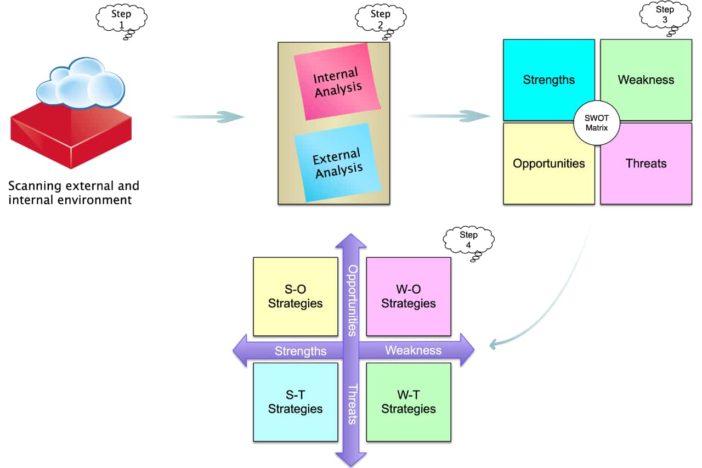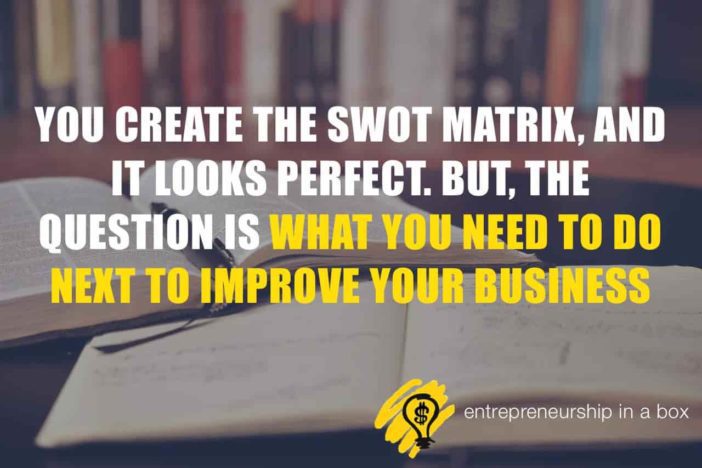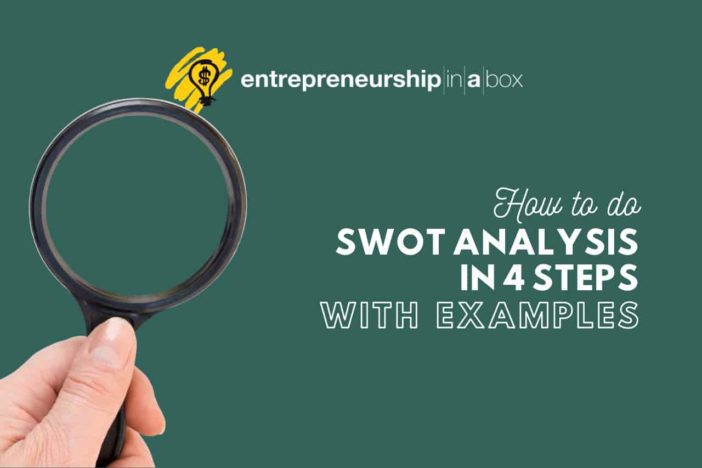SWOT analysis is a tool for planning, especially strategic planning for your company. Follow these four easy steps to make a SWOT analysis for your small business. The goal is to assess your strengths and weaknesses as your internal elements and opportunities and threats as external elements.
So, you can use SWOT analysis to evaluate Strengths and Weaknesses as the internal elements, and Opportunities, and Threats as external elements of your business. SWOT analysis can have a broad range of applications.
How to Do a SWOT Analysis for Your Small Business
Often I have seen how SWOT analysis begins and ends with the SWOT matrix. The SWOT matrix is the quadrant in which you list all SWOT elements. In such a way, you cannot achieve the full benefits from this analysis. For example, you create the matrix, and it looks perfect. But, the question is what you need to do next to improve your business.
As you can see, you will need to do something after you develop the SWOT matrix. So, you will need action steps. But, the action steps are the results of strategies, not the matrix.
According to this logic, the result of your SWOT analysis will need to be strategies with appropriate action steps to achieve the goals covered with each of the strategies from the analysis.
The following illustration presents a complete diagram of the SWOT analysis, which begins with scanning the internal and external environment of your company.

SWOT Analysis Step #1: Scanning External and Internal Environment
The purpose of this step is to find all internal and external factors that affect your work. You can list your strengths and weaknesses as internal factors and all your opportunities and threats as external factors.
As an organizational system, you are not alone in every aspect of your work. You have your business’ external and internal environment. The SWOT analysis will always begin by evaluating the current situation in respect of the internal and external environment of the company.
This evaluation of the current situation will lead to identifying internal and external factors that can influence your company. The internal factors can be strengths, but some of them can be a particular type of weakness of your small business. On the other side, the external factors can be opportunities or threats to your small business from outside. In this section, you will need to find all factors and list them according to the importance of your company. I will explain these elements of the SWOT analysis.
Strengths, Weakness, Opportunities and Threats
The purpose of this step is to find all internal and external factors that affect your work. You can list your strengths and weaknesses as internal factors and all your opportunities and threats as external factors. Strengths are all things that your company does very well. They are something that you do, and you are the best at it, something that differentiates you from the competition. Also, everyone has some weaknesses. Like strengths, weaknesses are internal characteristics of your business that can cover your team members, resources, procedures you are using, competencies, etc.
On the other side, you have opportunities that come from outside of your organization. These opportunities are chances that will happen something positive for your small business. But, they will not happen alone if you don’t start doing something about them. There are also threats that cover everything that can hurt your small business from the outside, like competition, supply chain problems, market price, etc. You don’t want your business to suffer because of these threats.
Questions Related to Scanning External and Internal Environment
The questions that you will need to answer here are following:
1. What are the legal factors that influence my business?
2. What are environmental factors that have an impact on my business?
3. What are political factors that affect my business?
4. What are the economic factors that have an impact on my business?
5. What are social factors that have an impact on my business?
6. What are the technological factors that influence my business?
7. What are competitive factors that have an impact on my business?
8. What are the managerial factors of my business?
9. What are the strategic factors of my business?
10. What are the structural factors of my business?
11. What are the goals of my company?
12. What are the operational factors of my business?
13. What are the technological factors of my business?
14. What are the cultural factors of my business?
15. What policy do I implement in my business?
16. What are factors related to leadership in your small business?
As you can see, by answering these 16 questions, you can find the most crucial factors from your company’s external and internal environment. Also, you need these factors to conduct a SWOT analysis.
The first seven questions are related to the external environment using the LE PEST C acronym. The following nine questions are related to your company’s internal environment (formal and informal subsystems). The formal subsystem questions are from 8 to 13, while informal subsystem questions are from 14 to 16.
SWOT Analysis Step #2: Internal and External Analysis
In this step, you will need to analyze the internal and external environmental factors that influence your company. The purpose here is to decide whether an internal factor is the strength or weakness of your business and whether an external factor is an opportunity or threat for your company.
Questions Related to Internal and External Analysis
The questions that you will need to answer here are following:
1. Which legal factors are your opportunity and, which of them are threats to your business?
2. Which environmental factors are your opportunity, and which of them are threats?
3. Which political factors are your opportunity and, which of them are your threats?
4. Which economic factors is your opportunity and, which of them is your threat?
5. Which social factors is your opportunity and, which of them is your threat?
6. Which technological factors are your opportunity and, which of them is your threat?
7. Which competitive factors are your opportunity and, which of them is your threat?
8. Which managerial factors are your strength and, which of them are your weakness?
9. Which strategic factors are your strength and, which of them are your weakness?
10. Which structural factors are your strength and, which of them are your weakness?
11. Which goals are your strength, and which of them are your weakness?
12. Which operational factors are your strength and, which of them are your weakness?
13. Which technological factors are your strength, and which of them are your weakness?
14. Which cultural factors are your strength, and which of them are your weakness?
15. Which politics are your strengths, and which of them are your weakness?
16. Which leadership factors are your strength, and which of them are your weakness?
SWOT Analysis Step #3: Construct the SWOT Matrix
Until now, you have already listed all influential factors from inside and outside your company. Also, you classify them as strengths, weaknesses, opportunities, and threats. Now you can continue with the construction of your SWOT matrix.
SWOT analysis matrix is a single quadrant constructed from SWOT acronyms, and in each quadrant, you need to place each of them already identified factors. This is an excellent graphic presentation of what is right and wrong in your company and what you can expect as an opportunity or threat.

SWOT Analysis Step #4: Define SWOT Strategies
What’s next? Is this enough to conduct the SWOT analysis? You need to know when you are analyzing that you need to expect future directions for the next actions at the end of the process.
If you stop here, you can not say that you have made a successful analysis. Therefore, for each combination of quadrants in the matrix, you must determine specific strategies for your company. From the SWOT matrix, you can extract four different strategies:
SWOT analysis S-O Strategies (Strength-Opportunities Strategies).
S-O strategies are the first strategies that you will need to develop. These strategies should take advantage of opportunities that fit the strengths of the business. You combine your strengths with your opportunities. The goal is to capitalize on the opportunities with your most significant strengths.
For example, let’s say you are great in new product development. So, when you see a new market opportunity like unsatisfied needs, you will use your strengths to develop a new product that will satisfy those needs on the market.
W-O Strategies (Weaknesses-Opportunities strategies).
But, you don’t only have strengths. Everyone has some weaknesses.
So, SWOT analysis W-O strategies are the second strategies you will want to develop. Why? Because you still want to capitalize on other opportunities even, you don’t have such significant strengths for them.
These strategies combine your weaknesses and opportunities. What does this mean? These strategies should allow you to overcome your weaknesses while you must capitalize on your opportunities.
For example, you can have low strengths related to creativity to create better products and services for your customers. On the other side, you know that the market is changing and you want to develop totally unique product. With SWOT analysis, you will define W-O strategies to achieve this goal. You will say, recruit the most creative people to overcome our current weaknesses and develop new product to capitalize on the market opportunities.
Swot Analysis S-T Strategies (Strength-Threat Strategies).
The third strategy you will develop with the SWOT analysis is S-T strategies that combine your strengths with possible threats.
Yes, there are not only opportunities outside your company. There are also threats that cover everything that can hurt your small business from the outside, like competition, supply chain problems, market price, etc. You don’t want your business to suffer because of these threats.
So, SWOT analysis with W-O strategies should allow you to take advantage of your strengths while eliminating or reducing threats from the environment.
For example, you have strengths related to the negotiation process. You know that there is a problem with supply management because one supplier has significant variability in orders. So, you will negotiate with the supplier and help them to reduce this variability.
Swot Analysis W-T Strategies (Weaknesses-Threats Strategies).
Here we talk about the combination of your internal weaknesses with possible outside strengths. You need to know that you will constantly be attacked by everyone outside your company, exactly in your most weak places.
So, the SWOT analysis will need to produce strategies that will help you eliminate weaknesses and prevent external threats.
For example, if your weaknesses are related to your production capacity, and you see that many competitors want to enter the market, you will need to improve capacity to eliminate possible threats from new competitors.
Questions Related to SWOT Strategies
The questions that you need to answer here are:
- What are my S-O Strategies?
- What are my W-O Strategies?
- Or, What are my S-T Strategies?
- What era my W-T Strategies?
A SWOT analysis gives us strategies for dealing with the current situation and preparing for the future. Covering both internal and external factors is a good starting point for personal improvement.
Next: SWOT Analysis Template



